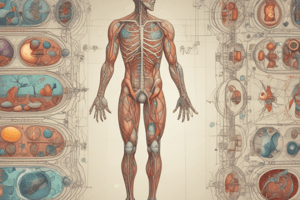Podcast
Questions and Answers
What is the primary focus of homeostatic mechanisms?
What is the primary focus of homeostatic mechanisms?
- To facilitate information transfer in physiological systems
- To regulate the internal environment within a range of values compatible with life (correct)
- To enhance cognitive functions
- To maintain the external environment
What is a key characteristic of a regulated variable?
What is a key characteristic of a regulated variable?
- It is unrelated to physiological systems
- It is kept within a limited range by physiological mechanisms (correct)
- It is constantly changing
- It is always in a state of equilibrium
What is the normal range of arterial PO2?
What is the normal range of arterial PO2?
- 50-70 mmHg
- 75-100 mmHg (correct)
- 120-150 mmHg
- 100-120 mmHg
What is NOT an example of a homeostatic mechanism?
What is NOT an example of a homeostatic mechanism?
Which organ is responsible for sensing changes in Ca2+ concentration?
Which organ is responsible for sensing changes in Ca2+ concentration?
Who is credited with introducing a control systems theory approach in physiology textbooks?
Who is credited with introducing a control systems theory approach in physiology textbooks?
What is the effector response to changes in blood glucose concentration in the fed state?
What is the effector response to changes in blood glucose concentration in the fed state?
What is the purpose of distinguishing between regulated and nonregulated variables?
What is the purpose of distinguishing between regulated and nonregulated variables?
What is the normal range of blood osmolality?
What is the normal range of blood osmolality?
What is an additional function of homeostatic mechanisms, as suggested by recent research?
What is an additional function of homeostatic mechanisms, as suggested by recent research?
Which sensor is responsible for detecting changes in core body temperature?
Which sensor is responsible for detecting changes in core body temperature?
What is the effect of changes in mean arterial pressure on the heart?
What is the effect of changes in mean arterial pressure on the heart?
What is the primary function of feedforward control mechanisms in maintaining homeostasis?
What is the primary function of feedforward control mechanisms in maintaining homeostasis?
Why is the definition of homeostasis being broadened to include anticipatory mechanisms?
Why is the definition of homeostasis being broadened to include anticipatory mechanisms?
What is the primary purpose of the model of a homeostatic regulatory system illustrated in Fig. 1?
What is the primary purpose of the model of a homeostatic regulatory system illustrated in Fig. 1?
What is the result of anticipatory increases in breathing frequency during exercise?
What is the result of anticipatory increases in breathing frequency during exercise?
What is the primary mechanism illustrated in the model of a homeostatic regulatory system in Fig. 1?
What is the primary mechanism illustrated in the model of a homeostatic regulatory system in Fig. 1?
What is the purpose of negative feedback mechanisms in maintaining homeostasis?
What is the purpose of negative feedback mechanisms in maintaining homeostasis?
Flashcards are hidden until you start studying




